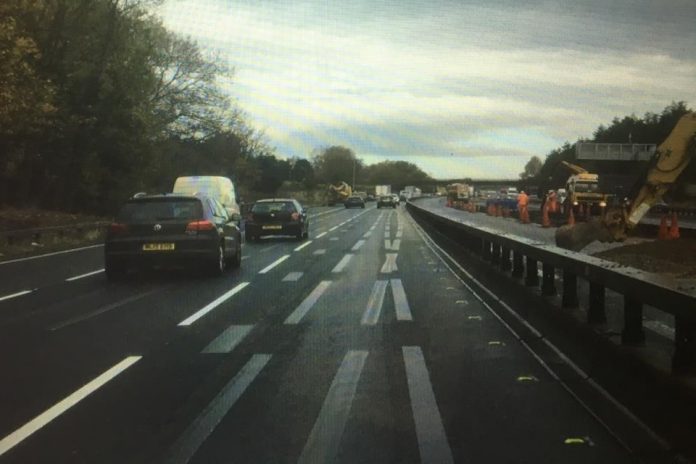When white road markings are removed, for example when road layouts change, the original lines can sometimes still appear as faint or ‘ghost’ markings, particularly in bright sunshine.
This can make the road ahead unclear for drivers. But, as this new footage shows, huge progress is being made in a trial on the M5 in the South West to eradicate the problem.
Making ‘’ghost markings’ vanish
Last year Highways England launched a £685,000 international research project to find a solution to issues around the removal of white lines and of ‘ghost markings’.
The competition set out to identify the most effective road markings that will also reduce damage to the surface when the lines are removed.
Seven new products are being tested to check their skid resistance and performance in the dry and wet as well as five systems for removing white lines to see if they are more effective.
Head of Lean and continuous improvement Martin Bolt, who has been overseeing the competition for Highways England, said:
The trial will continue until April but the results so far have been very promising and the safety benefits are already clear. We are very optimistic that we have identified some effective solutions to a worldwide problem.
We know that people find the ghost lines confusing but these new methods could make this issue disappear, creating safer journeys for drivers. They will also prevent damage to the road surface saving time and money.
We have certainly gaining a greater insight into the materials and processes we, and the road industry, could be using in future schemes.
One approach used in the trial has been to apply a black baseline first before adding the white line. This also fills in some of the voids in the road preventing the marking penetrating too deeply into the surface.
Another advantage is that it provides greater contrast between the marking and the road itself which will be increasingly important as autonomous vehicles are introduced.
Products from around the world were submitted for the competition. At a testing centre in the Spanish capital Madrid, the markings were then subjected to some two million ‘wheel overs’ to find the top products for skid resistance and performance.
The best seven were then also put to the test on the northbound carriageway of the M5, between junctions 20 (Clevedon, Nailsea) and 18 (Avonmouth).
Once testing is complete, the most successful products will be highlighted in research shared around the world and setting new high standards for the road industry.
The competition, launched in conjunction with Roadcare and Kier, was funded through Highways England’s Designated Fund for Innovation.
Keith Dawson, managing director of Roadcare, said:
It is refreshing to see such collaboration across a wide range of countries, All competitors should be congratulated for the attitude they have shown throughout this competition in sharing knowledge and best practice, from which we have gained an enormous amount of data based on facts not opinions.
Tom Tideswell, head of innovations at Kier Highways, said:
Ghost markings are confusing to road users which can lead to poor lane discipline through no fault of their own and, in worst case scenarios, cause incidents to occur.
During the trials, the five innovative road markings removal systems demonstrated their capabilities and have since provided very positive results which could lead to eradicating this issue and create safer journeys for road users.
They will also reduce the scarring/pothole creation by being less intrusive to the carriageway which in turn improves journey reliability by reducing the amount of closures required to carry out repairs in addition to saving money.
General enquiries
Members of the public should contact the Highways England customer contact centre on 0300 123 5000.
Media enquiries
Journalists should contact the Highways England press office on 0844 693 1448 and use the menu to speak to the most appropriate press officer.







